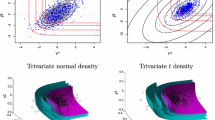Abstract
A recent paper by Prékopa (Ann. Oper. Res. 193(1):49–69, 2012) presented results in connection with Multivariate Value-at-Risk (MVaR) that has been known for some time under the name of p-quantile or p-Level Efficient Point (pLEP) and introduced a new multivariate risk measure, called Multivariate Conditional Value-at-Risk (MCVaR). The purpose of this paper is to further develop the theory and methodology of MVaR and MCVaR. This includes new methods to numerically calculate MCVaR, for both continuous and discrete distributions. Numerical examples with recent financial market data are presented.












Similar content being viewed by others
References
Artzner, P., Delbaen, F., Eber, J., & Heath, D. (1999). Coherent measures of risk. Mathematical Finance, 9(3), 203–228.
Atkinson, K. E. (1988). An introduction to numerical analysis (2nd ed.). New York: Wiley.
Ben-Tal, A., & Ben-Israel, A. (1991). A recourse certainty equivalent for decisions under uncertainty. Annals of Operations Research, 30, 3–44.
Ben-Tal, A., & Teboulle, M. (1986). Expected utility, penalty functions, and duality in stochastic nonlinear programming. Management Science, 32(11), 1445–1466.
Ben-Tal, A., Ben-Israel, A., & Teboulle, M. (1991). Certainty equivalents and generalized information measures: duality and extremal principles. Journal of Mathematical Analysis and Applications, 157, 211–236.
Boros, E., Elbassioni, K., Gurvich, V., Khachiyan, L., & Makino, K. (1998). An intersection inequality for discrete distributions and related generation problems (Vol. 2719). Berlin: Springer.
Bowers, N. L. J., Gerber, H. U., Hickman, J. C., Jones, D. A., & Nesbitt, C. J. (1997). Actuarial mathematics. Schaumburg: The Society of Actuaries.
Busemann, H. (2008). Convex surfaces. Mineola: Dover.
Cousin, A., & Di Bernadino, E. (2011). A multivariate extension of value-at-risk and conditional-tail-expectation. Université Lyon 1, ISFA, Laboratoire SAF.
Dentcheva, D., & Ruszczyński, A. (2009). Optimization with multivariate stochastic dominance constraints. Mathematical Programming, 117, 111–127.
Dentcheva, D., Prékopa, A., & Ruszczyński, A. (2000). Concavity and efficient points of discrete distributions in probabilistic programming. Mathematical Programming Series A, 89, 55–77.
Föllmer, H., & Schied, A. (2002). Convex measures of risk and trading constraints. Finance and Stochastics, 6, 429–447.
Gasca, M., & Sauer, T. (2000). On the history of multivariate polynomial interpolation. Journal of Computational and Applied Mathematics, 122, 23–35.
Jorion, P. (2006). Value at risk: the new benchmark for managing financial risk (3rd ed.). New York: McGraw-Hill.
Müller, A., & Stoyan, D. (2002). Comparison methods for stochastic models and risks. Chichester: Wiley.
Noyan, N., & Rudolf, G. (2012 to appear). Optimization with multivariate conditional value-at-risk constraints. Operatinal Research. Optimization online.
Pflug, G. C. (2000). Some remarks on the value-at-risk and conditional value at risk. In Probabilistic constrained optimization (pp. 272–281).
Prékopa, A. (1970). On probabilistic constrained programming. In Proceedings of the princeton symposium on mathematical programming (pp. 113–138). Princeton: Princeton University Press.
Prékopa, A. (1971). Logarithimic concave measures with applications to stochastic programming. Acta Scientiarum Mathematicarum, 32, 301–316.
Prékopa, A. (1973a). Contributions to the theory of stochastic programming. Mathematical Programming, 4, 202–221.
Prékopa, A. (1973b). On logarithmic concave measures and functions. Acta Scientiarum Mathematicarum, 34, 335–343.
Prékopa, A. (1988). Boole-Bonferroni inequalities and linear programming. Operational Research, 36(1), 145–162.
Prékopa, A. (1990). Dual method for a one-stage stochastic programming problem with random rhs obeying a discrete probability distribution. Operational Research, 34, 441–461.
Prékopa, A. (1990a). Sharp bounds on probabilities using linear programming. Operational Research, 38(2), 227–239.
Prékopa, A. (1990b). The discrete moment problem and linear programming. Discrete Applied Mathematics, 27, 235–254.
Prékopa, A. (1995). Stochastic programming. Dordrecht: Kluwer Academic.
Prékopa, A. (2003). Probabilistic programming. In A. Ruszczyński & A. Shapiro (Eds.), Hand books in operations research and management science (Vol. 10, pp. 267–351).
Prékopa, A. (2012). Multivariate value at risk and related topics. Annals of Operations Research, 193(1), 49–69.
Prékopa, A., Vizvári, B., & Badics, T. (1998). Programming under probabilistic constraint with discrete random variable. Dordrecht: Kluwer.
Saita, F. (2007). Value at risk and bank capital management. Amsterdam: Elsevier
Sauerbrei, W., Meier-Hirmer, C., Benner, A., & Royston, P. (2006). Multivariate regression model building by using fractional polynomials: description of SAS, STATA and R programs. Computational Statistics & Data Analysis, 50, 3464–3485.
Strang, G. (2007). Computational science and engineering. Cambridge: Wellesley-Cambridge Press.
Uryasev, S., & Rockafellar, R. (2000). Optimization of conditional value at risk. The Journal of Risk, 2, 21–41.
Vizvári, B. (1987). Beiträge zum Frobenius Problem. Dr. Sc. Nat. Dissertation. Techniche Hochschule Carl Schorlemmer, Leuna-Merseburg, Germany.
Author information
Authors and Affiliations
Corresponding author
Rights and permissions
About this article
Cite this article
Lee, J., Prékopa, A. Properties and calculation of multivariate risk measures: MVaR and MCVaR. Ann Oper Res 211, 225–254 (2013). https://doi.org/10.1007/s10479-013-1482-5
Published:
Issue Date:
DOI: https://doi.org/10.1007/s10479-013-1482-5




